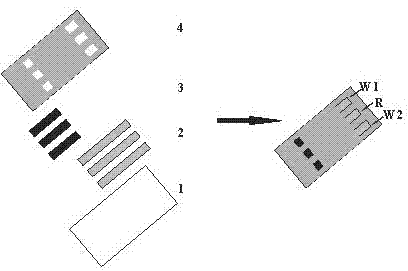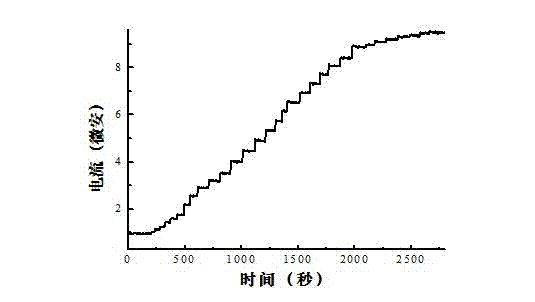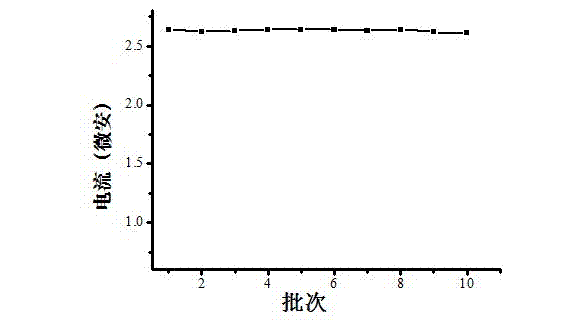Preparation of silk-screen printing electrode for rapidly diagnosing diabetic ketoacidosis
A technology of screen printing electrodes and hydroxybutyric acid, which is applied in the direction of material analysis, measuring devices, instruments, etc. by electromagnetic means, can solve the problems of long time required, inability to detect samples in real time, complicated operation, etc.
- Summary
- Abstract
- Description
- Claims
- Application Information
AI Technical Summary
Problems solved by technology
Method used
Image
Examples
Embodiment 1
[0016] Example 1 Preparation of screen-printed electrodes for rapid diagnosis of diabetic ketoacidosis
[0017] Dissolve 1 mg of nitrocellulose, 2 mg of hydroxybutyrate dehydrogenase, 2 mg of potassium ferricyanide, 2 mg of reduced coenzyme and 1 mg of chitosan in 10 mL of phosphate buffer solution with a pH of 7.4. 1% glutaraldehyde solution was added to the above mixed solution and stirred for 0.5 hours, 10 uL solution was added dropwise on the working electrode 1, and dried at 45°C for 0.5 h; 1 mg nitrocellulose, 2 mg potassium ferricyanide, 2 mg of reduced coenzyme and 1 mg of chitosan were dissolved in 10 mL of phosphate buffer solution with a pH of 7.4, 5uL of 1% glutaraldehyde solution was added to the above mixed solution and stirred for 0.5 hours, and 10 uL of the solution was added dropwise to On the working electrode 2, dry at 45°C for 0.5 h to obtain a screen-printed electrode for rapid diagnosis of diabetic ketoacidosis.
Embodiment 2
[0018] Example 2 The current response of different concentrations of β-hydroxybutyric acid on the screen-printed electrode test paper
[0019] First, accurately weigh 0.198 g of β-hydroxybutyric acid and dissolve it in 10 mL of PBS solution (containing 0.1 mol L -1 KClO 4 ), the concentration is 100 mmol·L -1 , diluted with PBS solution, prepared 0.01, 0.03, 0.05, 0.06, 0.08, 0.1, 0.3, 0.5, 0.8, 1.0, 1.5, 2.0, 2.5, 3.0, 3.5, 4.0, 4.5, 5.0, 5.5, 6.0, 6.5, 7.0 ,8.0,9.0 and 10.0 mmol·L -1 The β-hydroxybutyric acid solution, using CHI660B electrochemical workstation to measure the current response of different concentrations of β-hydroxybutyric acid on the screen printing electrode test paper, the potential is 0.4 V, such as figure 2 shown. The concentration of β-hydroxybutyric acid is 0.05 – 5.0 mmol·L -1 It has a good linear relationship with the current of the screen electrode test paper within the range, and the detection limit is 4.6 mmol·L -1 .
Embodiment 3
[0020] Example 3 Response of different batches of screen-printed electrode test paper to β-hydroxybutyric acid
[0021] First, accurately weigh 0.198 g of β-hydroxybutyric acid and dissolve it in 10 mL of PBS solution (containing 0.1 mol L -1 KClO 4 ), the concentration is 0.27 mmol·L -1 , 10 different batches of electrodes were used to measure the current response of β-hydroxybutyric acid on the screen-printed electrode test paper at a potential of 0.4 V, such as image 3 shown.
PUM
 Login to View More
Login to View More Abstract
Description
Claims
Application Information
 Login to View More
Login to View More - R&D
- Intellectual Property
- Life Sciences
- Materials
- Tech Scout
- Unparalleled Data Quality
- Higher Quality Content
- 60% Fewer Hallucinations
Browse by: Latest US Patents, China's latest patents, Technical Efficacy Thesaurus, Application Domain, Technology Topic, Popular Technical Reports.
© 2025 PatSnap. All rights reserved.Legal|Privacy policy|Modern Slavery Act Transparency Statement|Sitemap|About US| Contact US: help@patsnap.com



